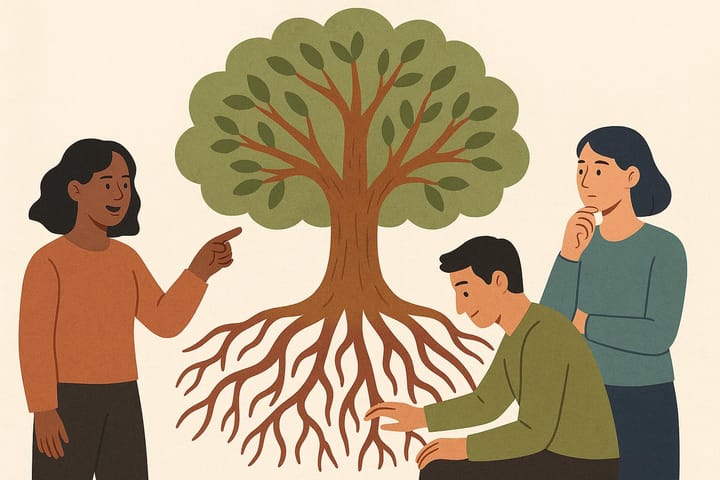Tired of Rambling? Use This Story Structure Instead
Learn how to structure your stories for clear communication and impactful leadership, using concise frameworks to engage your audience effectively.

Struggling to get your point across? Rambling can confuse your audience and weaken your message. A clear story structure can help.
Here’s how to craft concise, engaging stories that captivate and inspire action:
- Start with Context: Explain why your story matters in a single sentence.
- Present the Problem: Introduce a relatable challenge to create tension.
- Share the Solution: Show how the problem was resolved with key actions.
- Highlight the Outcome: Use specific results to demonstrate success.
- Deliver the Lesson: Wrap up with a takeaway your audience can apply.
For a quick, impactful story, keep it short by following the IRS formula:
- Intriguing beginning: Set the scene (30 seconds).
- Riveting middle: Outline the problem and actions (1-2 minutes).
- Satisfying end: Share the outcome and lesson (30 seconds).
Use this structure in meetings, updates, or one-on-one conversations to make your communication clear, focused, and memorable.
Seven Ways to Structure Your Storytelling
Key Parts of a Leadership Story
Every great story has essential parts that work together to deliver a clear, impactful message. Here's how each element contributes to the whole.
Start with Context
Kick off your story with a relevance statement - a single sentence explaining why your story matters. Answer these key questions:
- Where and when did this happen?
- Who was involved?
- Why should your audience care?
"Business storytelling is the mindful use of storytelling to make a business point, to engage, influence, and inspire." - Shawn Callahan
Present the Problem
Introduce a challenge that your audience can relate to. Karen Eber puts it simply:
"When you run out of conflict, you run out of story."
The problem should feel real and compelling, creating enough tension to keep your audience curious about what happens next.
Share the Solution and Learning
Wrap up your story by showing how the challenge was handled. Leadership expert Esther Choy highlights the importance of structure:
"Structure is critical to stories, just as it is to buildings. When the structure of a building is solid, we don't give it a second thought! Same goes for story structure, which holds all the elements together, usually without your realising it. In fact, all strong stories share the same basic three-act story structure." - Esther Choy, Founder, Leadership Story Lab
Karen Eber also stresses the importance of a clear takeaway:
"The takeaway is the step most people skip in storytelling, but it's the very thing that can ensure your story resonates as intended."
Each part of the story plays a specific role: context makes it relevant, the problem draws people in, and the solution provides insight and inspires action.
5 Steps to Build Your Story
Craft concise, engaging stories with these five straightforward steps. This approach helps you replace long-winded messages with clear, impactful narratives.
Step 1: Describe the Scene
Start by setting the stage with essential details that captivate your audience. Focus on elements that make the story relatable and relevant.
"The story moves forward while also including vivid details to keep the reader's senses engaged." – Esther Choy
A good scene-setter is brief yet engaging. For instance:
"Getting kicked out of your apartment is not fun, but if you have a support system, it can be a kick in the right direction."
This kind of opening grabs attention while providing context.
Step 2: Define the Challenge
Clearly outline the main challenge. Avoid overwhelming your audience with excessive details - stick to the core problem that needs solving.
A strong challenge statement should:
- Identify the obstacle or issue
- Explain why it matters
- Keep the focus narrow
For example, you might say: "Our steady growth in the Asian market hit a plateau due to intense competition".
Step 3: List Key Actions
Highlight the specific actions taken to address the challenge. Focus on steps that directly contributed to solving the problem:
- Limit to 2-3 main actions
- Provide clear, concrete details
- Link each action back to the challenge
Step 4: Show the Outcome
Share the results of your actions in a measurable way. Avoid vague phrases like "it went well" or "things got better." Instead:
- Use specific numbers or data
- Compare the situation before and after
- Mention any unexpected benefits
Step 5: Share the Lesson
Wrap up with a takeaway that turns your story into a learning moment. A concise, impactful conclusion ensures your audience walks away with a clear message.
Each section can be short - sometimes just a sentence or two is enough. The aim is to keep your story focused and impactful without unnecessary details.
Here’s a quick reference to keep your story on track:
| Story Element | Key Question | Purpose |
|---|---|---|
| Scene | Where/when did this happen? | Sets the context |
| Challenge | What needed to change? | Adds tension |
| Actions | What steps were taken? | Shows the solution |
| Outcome | What happened? | Demonstrates results |
| Lesson | What did we learn? | Delivers value |
How to Keep Stories Short and Clear
Know Your Story's Purpose
Start by identifying the purpose of your story. What do you want your audience to take away or do? Stick to details that directly support this goal. For example, if you're explaining why a project is delayed, focus on the main reasons instead of recounting every meeting or minor issue.
"A story is great because of its structure, not length." - Karen Eber
Set Time and Structure Limits
Use the 'IRS' formula to keep your story concise and impactful. Here's how it breaks down:
| Section | Purpose | Time Limit |
|---|---|---|
| Intriguing beginning | Set the context | 30 seconds |
| Riveting middle | Highlight the challenge and actions | 1-2 minutes |
| Satisfying end | Share the outcome and lessons | 30 seconds |
Keep each section brief, using one or two sentences to convey only the most important points.
Test and Improve Your Story
Once your story is structured, work on refining it. Practise telling it and get feedback to make it better. Aim to make your story relatable and engaging by adding familiar and surprising elements.
"Don't worry about telling a short story, focus on telling an engaging one. A short story without a solid structure or anything to draw you in falls flat. Structure a story well, and make it relatable, familiar, and unexpected. That will earn you permission to tell more stories." - Karen Eber
Ask yourself these questions to fine-tune your story:
- Does every detail support the main message?
- Can key points be simplified further?
- Would removing any part make the story stronger?
The key to a memorable story isn't its length; it's the structure and engagement. A well-structured two-minute story can leave a lasting impression, while a drawn-out 10-minute one may not.
Where to Use This Story Structure
A well-organised story structure can elevate various leadership scenarios, making your communication more engaging and effective.
Leading Team Meetings
Did you know the average person spends 31 hours per month in unproductive meetings? A structured story approach can turn these sessions into opportunities that grab attention and lead to action.
To make meetings more meaningful, start with a story that frames your message. For instance, when presenting a new project timeline, share a quick story about a past success with a similar strategy:
| Story Element | Meeting Application | Time |
|---|---|---|
| Context | Outline the current situation and goals | 30 seconds |
| Challenge | Highlight key obstacles or opportunities | 1 minute |
| Resolution | Present the action plan and expected outcomes | 30 seconds |
"People want to be valued members of a winning team on an inspired mission." - Jennifer Aaker, Stanford Graduate Business School
This simple narrative method not only improves team meetings but also sets the tone for clear and compelling stakeholder updates.
Giving Stakeholder Updates
For stakeholder updates, combine the BLUF (Bottom Line Up Front) method with storytelling to keep your audience engaged. Here’s how you can structure your updates:
- Open with the most important information and any required actions in 2-3 sentences.
- Back up your key points with relevant data.
- Stay focused on the elements critical to decision-making.
This approach ensures clarity and keeps your stakeholders focused on what truly matters.
Having 1-on-1 Conversations
One-on-one conversations thrive on structured storytelling, especially when giving feedback or discussing development opportunities. Regular weekly meetings become more impactful when stories are used to illustrate key points and foster connection.
When incorporating stories into one-on-ones:
- Share personal experiences that highlight growth.
- Focus your narratives on opportunities for development.
- Use a clear four-part structure to deliver feedback effectively.
Conclusion: Better Stories, Better Leadership
Structured storytelling transforms scattered ideas into clear, action-driven messages. By consistently using reliable frameworks, you can organise your thoughts and keep your audience engaged.
Think of story structure as the backbone of your message. Just like a well-built structure relies on strong engineering, your stories need solid frameworks to make a lasting impression.
Frameworks like IRS (Intriguing beginning, Riveting middle, Satisfying end) and A-B-T (And, But, Therefore) are practical tools for a variety of scenarios. Whether you're running a quick team meeting or addressing the board, these approaches can help you:
| Communication Goal | How Structure Helps | Result |
|---|---|---|
| Clarity | Organises ideas logically | Makes your message easy to follow |
| Engagement | Creates a natural flow | Keeps attention on key points |
| Action | Guides towards clear outcomes | Motivates meaningful steps forward |
These examples highlight how a structured approach not only clarifies your ideas but also ensures your audience understands and acts on them.
Storytelling with purpose isn’t about aiming for perfection - it’s about practising and refining your delivery. The more you use these frameworks, the more naturally they’ll shape your communication. This allows you to focus on delivering your message confidently and effectively.
Using structured storytelling builds trust and encourages action. Your stories become tools for inspiring change - try these techniques in your next meeting to connect with your audience and drive results.
FAQs
How can I use the IRS formula to make my business communication clearer and more engaging?
The IRS formula is a simple storytelling framework that can transform your business communication. It stands for Intriguing beginning, Riveting middle, and Satisfying end. This structure helps you organise your ideas into a concise, engaging story, even if it's just a few sentences long.
By starting with an attention-grabbing opening, following with a compelling middle that builds interest, and wrapping up with a clear and impactful conclusion, you can ensure your message is both clear and memorable. This approach works well for meetings, presentations, and even one-on-one conversations, helping your ideas resonate with any audience.
What mistakes should I avoid when structuring a story to keep it clear and engaging?
To avoid rambling and ensure your story stays clear and impactful, steer clear of these common pitfalls:
- Lack of structure: Without a clear framework, your story can become confusing or meander. Use a simple structure like context, conflict, outcome, and takeaway to keep it focused.
- Too much detail: Including unnecessary details can overwhelm your audience. Focus on the key points that support your message.
- Unclear purpose: Every story should have a clear goal or takeaway. Make sure your audience understands why the story matters.
By keeping your story concise and purposeful, you’ll ensure it resonates with your audience and delivers your message effectively.
How can structured storytelling help leaders communicate more effectively in meetings and updates?
Structured storytelling can help leaders communicate with greater clarity and impact during team meetings and stakeholder updates. By following a clear framework, such as context, conflict, outcome, and takeaway, leaders can organise their thoughts and ensure their message is engaging and easy to follow.
This approach not only makes communication more concise but also helps the audience connect with the message on a deeper level. Whether you're presenting a strategy, addressing challenges, or sharing results, structured storytelling ensures your points are purposeful and memorable, fostering better understanding and collaboration.



